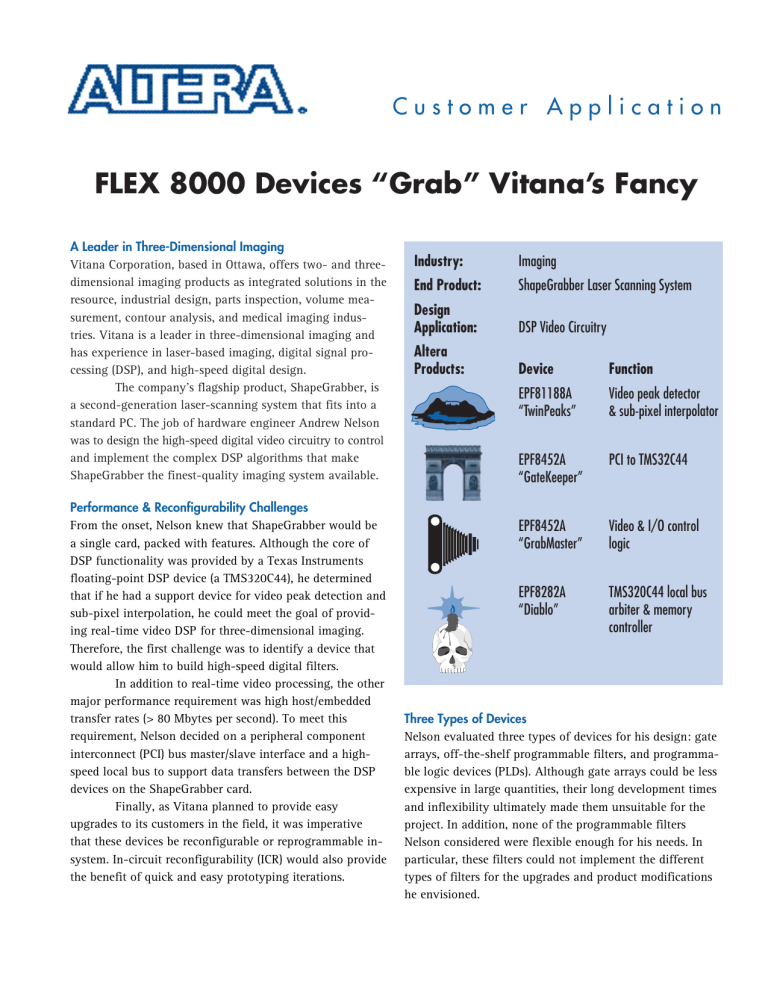
Customer Application
FLEX 8000 Devices “Grab” Vitana’s Fancy
A Leader in Three-Dimensional Imaging
Vitana Corporation, based in Ottawa, offers two- and threedimensional imaging products as integrated solutions in the
resource, industrial design, parts inspection, volume measurement, contour analysis, and medical imaging industries. Vitana is a leader in three-dimensional imaging and
has experience in laser-based imaging, digital signal processing (DSP), and high-speed digital design.
The company’s flagship product, ShapeGrabber, is
a second-generation laser-scanning system that fits into a
standard PC. The job of hardware engineer Andrew Nelson
was to design the high-speed digital video circuitry to control
and implement the complex DSP algorithms that make
ShapeGrabber the finest-quality imaging system available.
Performance & Reconfigurability Challenges
From the onset, Nelson knew that ShapeGrabber would be
a single card, packed with features. Although the core of
DSP functionality was provided by a Texas Instruments
floating-point DSP device (a TMS320C44), he determined
that if he had a support device for video peak detection and
sub-pixel interpolation, he could meet the goal of providing real-time video DSP for three-dimensional imaging.
Therefore, the first challenge was to identify a device that
would allow him to build high-speed digital filters.
In addition to real-time video processing, the other
major performance requirement was high host/embedded
transfer rates (> 80 Mbytes per second). To meet this
requirement, Nelson decided on a peripheral component
interconnect (PCI) bus master/slave interface and a highspeed local bus to support data transfers between the DSP
devices on the ShapeGrabber card.
Finally, as Vitana planned to provide easy
upgrades to its customers in the field, it was imperative
that these devices be reconfigurable or reprogrammable insystem. In-circuit reconfigurability (ICR) would also provide
the benefit of quick and easy prototyping iterations.
Industry:
Imaging
End Product:
ShapeGrabber Laser Scanning System
Design
Application:
DSP Video Circuitry
Altera
Products:
Device
Function
EPF81188A
“TwinPeaks”
Video peak detector
& sub-pixel interpolator
EPF8452A
“GateKeeper”
PCI to TMS32C44
EPF8452A
“GrabMaster”
Video & I/O control
logic
EPF8282A
“Diablo”
TMS320C44 local bus
arbiter & memory
controller
Three Types of Devices
Nelson evaluated three types of devices for his design: gate
arrays, off-the-shelf programmable filters, and programmable logic devices (PLDs). Although gate arrays could be less
expensive in large quantities, their long development times
and inflexibility ultimately made them unsuitable for the
project. In addition, none of the programmable filters
Nelson considered were flexible enough for his needs. In
particular, these filters could not implement the different
types of filters for the upgrades and product modifications
he envisioned.
Customer Application
ShapeGrabber Block Diagram
50-Pin Digital Video Connector
TwinPeaks
16
Video
Input
DC
Restore
Low-Pass
Filter
12-Bit, 10-MHz Analog
to Digital Convertor
External Sync In
Clock
Generator
GenLock
Controller
GrabMaster
to DSP, I/O
Power
Supply
Digital
Analog
External
to TwinPeaks
Video and I/O Control Logic
Digital Output
4
Digital Output
4
Laser Enable
4
Laser Mod.
4
System I/O
6
External Sync
4
Peripheral Bus
SyncGen
Controller
Local Bus
PCI Bus
Interface
Bus Mastering,
DMA, and I/O
Controller
GateKeeper
Video Peak Detector and
Memory Control Logic
Frame Buffer
256K × 16
VRAM
Peak Buffer
32K × 16
SRAM
50-Pin
Connector
128K × 32
SRAM
2 IndustryPack
Module Sites
16
Diablo
2 TI Module
Sites (TIM)
PCI Bus
JTAG
Debugging Port
50
50
50-MHz
TMS320C44
DSP Device
PCI/DSP Interface and
Peripheral Controller
50-Pin Connectors (2)
Local Bus
Arbiter and
DRAM
Memory
Controller
16M × 32
DRAM
to All JTAG-Capable Devices
Global Bus
Nelson had some previous experience with programmable anti-fuse devices; however, the need to configure the devices in-circuit in the field precluded his use of
these one-time-programmable devices. He also considered
using field-programmable gate arrays (FPGAs) with segmented routing, but ultimately decided against them out of
concern for their poor routability and his need to guarantee
timing and fitting with each design iteration through future
upgrades. The PLDs that met all of his needs from the
initial examination were Altera FLEX 8000 devices.
The Implementation
When creating the designs for the FLEX 8000 devices,
Nelson began by grouping functions and assigning descriptive names and icons to the devices that would perform the
functions. It didn’t take long before the TwinPeaks,
GateKeeper, GrabMaster, and Diablo devices had lives of
their own. The devices and their functionality are summarized below.
Of the four designs, Nelson found TwinPeaks to be
by far the most challenging. He designed TwinPeaks to be a
video preprocessor, with the intention of having the device
perform peak detection and validation external to the DSP
device, freeing up more of its processing time. He chose the
EPF81188A device for this design, which included two FIR
filters. The peak locator was a 16-bit, 8-tap filter and the
peak location validator was a 14-bit, 3-tap filter. Both
filters ran at video rates. The TwinPeaks design also contained the sub-pixel interpolator, which interpolates the
position of the peak to 1/64 of a pixel. If these functions
had been placed in the DSP device, according to Nelson,
they would have consumed 80% of the device’s functionality. But by using the EPF81188A as a DSP coprocessor, he
was able to meet the speed requirements.
Customer Application
Development Time
The first-generation ShapeGrabber had used anti-fusebased devices. It had taken the design team about two
painful months to build that version-painful both in terms
of design and cost because the devices had to be thrown
away after each iteration. However, using Altera’s
MAX+PLUS II software, Nelson designed the second-generation ShapeGrabber in less than a day, and completed full
simulation of the entire design in the following two weeks.
To create the design, Nelson used MAX+PLUS II
version 6.0, which supports the library of parameterized
modules (LPM). This solution permitted him to create
custom building blocks that were not limited by conventional logic sizes. Because the LPM functions were optimized for any target device he chose, he was able to
concentrate on the design without worrying about the
lower-level implementation details. MAX+PLUS II version
6.0 also had better device fitting support, as evidenced
when the software fit designs faster and easier than the
previous version.
FLEX 8000 devices support in-circuit reconfigurability (ICR), which vastly decreased the amount of time it
took Nelson to prototype ShapeGrabber. He could make a
design change, implement it, and physically test it in minutes.
Using ICR and the Altera Hardware Description Language
(AHDL), Nelson was able to make, simulate, and fully test
10 to 20 design changes a day. With these rapid prototyping features, Vitana’s time-to-market decreased significantly.
In-Field Upgrades via ICR & the PCI Bus
One of the features Nelson had planned for this generation
of ShapeGrabber was the ability to perform in-field upgrades
and modifications to meet special customer needs. He
accomplished this by reconfiguring the FLEX 8000 devices
via the PCI bus. He wrote a software driver that resides on
the host platform and converts a FLEX 8000 programming
file to configuration data. The driver also downloads the
configuration data to the appropriate FLEX 8000 device via
the PCI bus upon startup. All that is required for upgrades
or modifications is a single new programming file that can
be sent to the customer electronically.
TwinPeaks Block Diagram
from Analog
to Digital
Convertor &
Local Bus
16
Frame Buffer
Controller
12
8
Microprocessor 6
Interface
FLEX 8000 Device
Peak Detector
(FIR Filter)
Validation Logic
(FIR Filter &
Comparator)
14
Sub-Pixel
Interpolator
6
10
from
GrabMaster
from
GrabMaster
Pixel Clock
Video Line
Counters
10
Pixel
Counter
10
16
Peak Buffer
Controller
16
Peak
Positions
Customer Application
Some of the modifications Nelson is planning
include changing the filtering in the TwinPeaks design. For
example, instead of peak detection, he may consider valley
detection, or performing low-pass or high-pass filtering on
the video signal. In any case, ICR gives Vitana a greater
ability to service customers in the field.
“I can truly say that FLEX 8000
devices, along with MAX+PLUS II
software, were the ideal choices for
creating our product.”
Conclusion
“Having worked with a number of device architectures and
design packages, I can truly say that using FLEX 8000
devices along with the MAX+PLUS II software were the
ideal choices for creating our product,” said Nelson.
“ShapeGrabber meets our goal of being the most advanced
three-dimensional imaging product worldwide.”
Altera Offices
Altera Corporation
2610 Orchard Parkway
San Jose, CA 95134-2020
Telephone: [408] 894-7000
Fax: [408] 944-0952
Altera European Headquarters
Solar House
Globe Park
Fieldhouse Lane
Marlow
Bucks SL7 1TB, England
Telephone: 01628 488800
Fax: 01628 890078
—Andrew Nelson
Hardware Engineer
Altera Japan Ltd.
Shinjuku Mitsui Bldg.
2-1-1, Nishi-Shinjuku, Shinjuku-ku
Tokyo 163-04, Japan
Telephone: 03 3340-9480
Fax: 03 3340-9487
Copyright © 1996 Altera Corporation. AHDL, Altera, FLEX, FLEX 8000, MAX+PLUS II, and specific device designations are trademarks and/or service marks of Altera Corporation in the United States and
other countries. Other brands or products are trademarks of their respective holders. The specifications herein are subject to change without notice. All rights reserved.
M-CAS-VITANA-01




